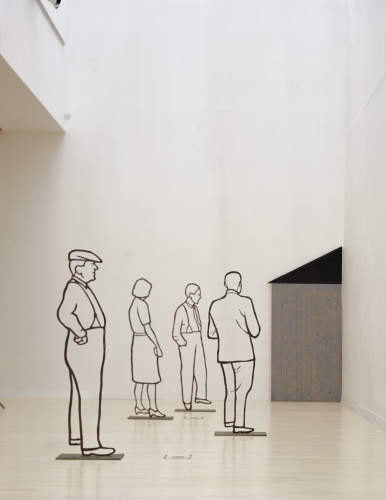National Gallery of Tirana, 24. June, 2016 – 14. August
Selected works from the international collection of Ludwig Museum – Museum of Contemporary Art, which give insight into the recent past and contemporary art of Hungary through primarily photo- and multimedia-based works, often involving the figure of the artist. The pieces on show from the collection established in 1989, the year of the regime change, are documents of an era, imprints of the ideals and values that permeate everyday life and art – as conceived by the collection’s founder, Peter Ludwig. It is with great expectations that we now present these works to the audience of the National Gallery of Tirana.
Related contents

Time-Laces II
In this work Bea Veszely appropriates famous depictions of women from the history of art, or more precisely, their photographic reproductions.

Time-Laces V
In this work Bea Veszely appropriates famous depictions of women from the history of art, or more precisely, their photographic reproductions.

Sickle and Hammer 1–4
At the beginning of the 1970s, Sándor Pinczehelyi turned his attention to the appropriation and decoding of the symbols of the labour movement, by way of creating conceptual art and graphic design.

Details from the Ten Superfluous GesturesV/1
Tibor Gyenis’ photographs usually record actions that feature himself as main character: the “hobby artist” doing his work against all odds.

Time-Laces IV
In this work Bea Veszely appropriates famous depictions of women from the history of art, or more precisely, their photographic reproductions.

Time-Laces III
In this work Bea Veszely appropriates famous depictions of women from the history of art, or more precisely, their photographic reproductions.

Untitled (Blue Panel No. 1-2.)
Ádám Kokesch makes glossy coloured paintings with a special, so-called “hinterglas” technique, and also combines these images with other objects to construct Futurist installations and models, which perplex the viewer. These compositions are attached to a TV-stand or a photo tripod, or the wall.

Private Gynaecological Surgery
This installation – comprising three gynaecological examination chairs covered with rabbit hair, moss, and red velvet – is one of those works of the artist that model the interrelationship of the self and its environment, including basic perception or socially determined roles.

Grey House
László Fehér achieved international recognition at the 1990 Venice Biennale. Reduced to a few colours and basic elements, his paintings created at the time of political changes at the end of the 1980s return the viewer to the sombre, gloomy atmosphere of the 1950s.

Details from the Ten Superfluous Gestures V/III
Tibor Gyenis’ photographs usually record actions that feature himself as main character: the “hobby artist” doing his work against all odds.

Reversible and Interchangeable Phases of Motion No. 4
Dóra Maurer’s conceptual series explores the changes in visual meaning: photographs of the phases of a given subject’s movement are arranged in different orders, thereby modifying how the series reads.

Kádár's Summer House No. 4.
The significance of the Bauhaus-style building in Csaba Nemes’ painting lies in the fact that it was this two-storey, not too spacious house where János Kádár, first secretary of the Hungarian Socialist Workers’ Party and the political leader of Hungary between November 1956 and May 1988 took a r

Cotton-pickers in Kazakhstan
László Lakner made his photorealist painting by enlarging a photograph found in the major Soviet illustrated magazine Orgoniok (no 49., 1972.) featuring Kazakh cotton-pickers.

Dirty Money
János Sugár – an internationally known artist and teacher at the art academy – used stencil and spray-paint to create the following text on the facade of a privately owned exhibition space in central Budapest: “Wash your dirty money with my art”.

Details (János Major) No. 1-5.
„András Baranyay is a core member of the IPARTERV generation, even though he never overestimated the importance of this artist group”, writes László Beke, and this is also true of the graphic artist János Major, Baranyay’s friend, the man in quasi-portrait from 1973.







